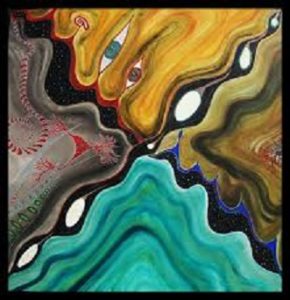Wise Relationship Part II: Entanglements–Who Is Doing What To Whom?

photo Farshad Sanaee
Wise Relationship, Part II Entanglement: Who Is Doing What To Whom?
The Calm at the Center of the Storm
Human beings are relational beings. We spend the majority of our lives conversing and interacting with others, continually mixing minds with others (including in cyberspace). It is not an exaggeration to say that we are made of relationship.
Because relationship is so foundational, it is an important topic for meditative exploration and contemplation. In general, bringing Presence to the intimate edge of our connection with others can be revealing, and it holds the potential to transform how we relate.
Relational inquiry is broad in scope. For example, we can explore who we like/dislike, and why. (And what exactly is entailed in “liking someone”?) We can notice what parts of ourselves show up in particular situations; what feelings and psychological needs come up; what is it that wants/needs to be known or spoken. Following the guidelines of Buddhist practice, we can investigate the surface of our connection with others both externally (what is occurring between us) and internally (how we are holding the relationship in mind).
Here I want to focus on a particular set of relational difficulties in close relationships that we may call entanglement. I am not using this term as a euphemism for a dysfunctional connection with someone, but rather to point to repetitive painful ‘knots’ of entangled emotion (often in the form of fights) which are determined by the emotional baggage of both parties. This can become especially problematic when both people in the relationship have similar psychological issues – which is often the case because such vulnerabilities are part of what attracts us to particular others in the first place.
A very common entanglement is that which occurs when both people feel wounded and/or angry at the same time and each blames the other for having started it. (A pervasive dynamic in couples!) This is by its very nature a reactive situation, and the anger and/or pain that arises can be emotionally destabilizing.
What are skillful means for dealing with entanglements such as this? In the usual application of mindfulness practice to the situation, the general “prescription” goes by the acronym R.A.I.N. : recognition, acceptance, investigation, and non-identification.[i] In order to see the truth of what is happening, it is recommended that we pause the reactive pattern and drop the story in order to go beneath the surface level of the moment which is clouded with emotions and habitual thinking.
But finding our way past the cul de sac of entanglement is also helped by deepening our emotional understanding of how each person’s patterns of attachment are challenged by the partner’s. More than simple awareness, and beyond cognitive understanding of the situation, we need to feel our way into the upset. I often liken this to feeling for a splinter at the center of an area of inflammation on the skin. True transformation of entanglements depends on our ability to truly meet the emotional challenge on its own terms.
Inquiring deeply into the question who is doing what to whom? can begin to detangle the situation. Our initial idea of what is happening needs to include, for example, the recognition that whatever is happening is a co-arising event. To see the relational difficulty in terms of we instead of you vs. me is itself an important step forward.
Often the best place to begin to see more deeply into who is doing what to whom? is in contemplation after the fact. Once the upset has passed and we have recovered our self-reflective function, we can step back and try to gain some perspective on the reactive pattern that each of us reciprocally triggers in the other. A period of open-awareness sitting meditation provides a good opportunity to see more clearly what is going on for us. What comes up in awareness helps to reveal what we are defending, what we need to be right about, and what is at stake.
The inquiry question who is doing what to whom? may show us the relational roots of the reactive pattern we are caught in. Associations to earlier similar experiences in family of origin or in other relationships may be explored. Which actual others did what to you (or someone else) ? And/or, is this something you have ever done to someone else? It is helpful to learn to notice more clearly when we engage psychological defenses in order to avoid experiencing, admitting to, or dealing with unwanted feelings. Ideally, by examining the pattern and its network of associations in the mind, we can come to an empathic understanding of the entanglement that is inclusive of the pain of both partners and free of blame.
The question of who is doing what to whom? is a good inquiry practice. In the heat of difficult interactions with others, simply engaging with the question who is doing what to whom? may sometimes help us to get free from whatever relational box we have gotten trapped in. There is calm at the center of every relational storm where we can remind ourselves to look for what it is we love in this person we are upset with and where we can remember our relational aspirations.
At a deeper level, inquiring deeply into who is doing what to whom can help to free us from the ego identifications that keep us stuck. Relational entanglements can show us the living reality that we are intersubjective beings in a constant and fluid process of relational exchange with others. Experiential awareness of this “interbeing” holds the key to transformation of entanglement.
[i] A newer version of this teaching uses the directives to “Recognize, Allow, Investigate, and Nurture”.
